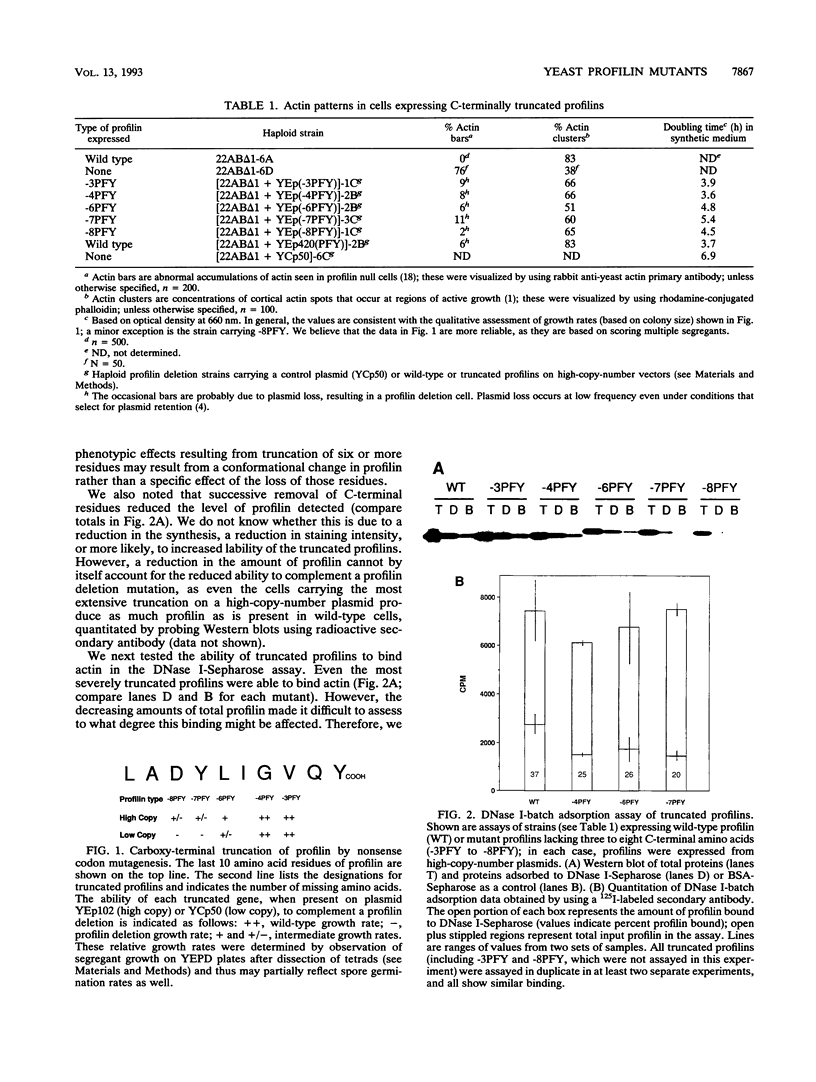Abstract
We have mutated two regions within the yeast profilin gene in an effort to functionally dissect the roles of actin and phosphatidylinositol 4,5-bisphosphate (PIP2) binding in profilin function. A series of truncations was carried out at the C terminus of profilin, a region that has been implicated in actin binding. Removal of the last three amino acids nearly eliminated the ability of profilin to bind polyproline in vitro but had no dramatic in vivo effects. Thus, the extreme C terminus is implicated in polyproline binding, but the physiological relevance of this interaction is called into question. More extensive truncation, of up to eight amino acids, had in vivo effects of increasing severity and resulted in changes in conformation and expression level of the mutant profilins. However, the ability of these mutants to bind actin in vitro was not eliminated, suggesting that this region cannot be solely responsible for actin binding. We also mutagenized a region of profilin that we hypothesized might be involved in PIP2 binding. Alteration of basic amino acids in this region produced mutant profilins that functioned well in vivo. Many of these mutants, however, were unable to suppress the loss of adenylate cyclase-associated protein (Cap/Srv2p [A. Vojtek, B. Haarer, J. Field, J. Gerst, T. D. Pollard, S. S. Brown, and M. Wigler, Cell 66:497-505, 1991]), indicating that a defect could be demonstrated in vivo. In vitro assays demonstrated that the inability to suppress loss of Cap/Srv2p correlated with a defect in the interaction with actin, independently of whether PIP2 binding was reduced. Since our earlier studies of Acanthamoeba profilins suggested the importance of PIP2 binding for suppression, we conclude that both activities are implicated and that an interplay between PIP2 binding and actin binding may be important for profilin function.
Full text
PDF









Images in this article
Selected References
These references are in PubMed. This may not be the complete list of references from this article.
- Adams A. E., Pringle J. R. Relationship of actin and tubulin distribution to bud growth in wild-type and morphogenetic-mutant Saccharomyces cerevisiae. J Cell Biol. 1984 Mar;98(3):934–945. doi: 10.1083/jcb.98.3.934. [DOI] [PMC free article] [PubMed] [Google Scholar]
- Amatruda J. F., Cannon J. F., Tatchell K., Hug C., Cooper J. A. Disruption of the actin cytoskeleton in yeast capping protein mutants. Nature. 1990 Mar 22;344(6264):352–354. doi: 10.1038/344352a0. [DOI] [PubMed] [Google Scholar]
- Bradford M. M. A rapid and sensitive method for the quantitation of microgram quantities of protein utilizing the principle of protein-dye binding. Anal Biochem. 1976 May 7;72:248–254. doi: 10.1006/abio.1976.9999. [DOI] [PubMed] [Google Scholar]
- Bruschi C. V., Comer A. R., Howe G. A. Specificity of DNA uptake during whole cell transformation of S. cerevisiae. Yeast. 1987 Jun;3(2):131–137. doi: 10.1002/yea.320030209. [DOI] [PubMed] [Google Scholar]
- Eichinger L., Noegel A. A., Schleicher M. Domain structure in actin-binding proteins: expression and functional characterization of truncated severin. J Cell Biol. 1991 Feb;112(4):665–676. doi: 10.1083/jcb.112.4.665. [DOI] [PMC free article] [PubMed] [Google Scholar]
- Fedor-Chaiken M., Deschenes R. J., Broach J. R. SRV2, a gene required for RAS activation of adenylate cyclase in yeast. Cell. 1990 Apr 20;61(2):329–340. doi: 10.1016/0092-8674(90)90813-t. [DOI] [PubMed] [Google Scholar]
- Gerst J. E., Ferguson K., Vojtek A., Wigler M., Field J. CAP is a bifunctional component of the Saccharomyces cerevisiae adenylyl cyclase complex. Mol Cell Biol. 1991 Mar;11(3):1248–1257. doi: 10.1128/mcb.11.3.1248. [DOI] [PMC free article] [PubMed] [Google Scholar]
- Gieselmann R., Mann K. ASP-56, a new actin sequestering protein from pig platelets with homology to CAP, an adenylate cyclase-associated protein from yeast. FEBS Lett. 1992 Feb 24;298(2-3):149–153. doi: 10.1016/0014-5793(92)80043-g. [DOI] [PubMed] [Google Scholar]
- Goldschmidt-Clermont P. J., Kim J. W., Machesky L. M., Rhee S. G., Pollard T. D. Regulation of phospholipase C-gamma 1 by profilin and tyrosine phosphorylation. Science. 1991 Mar 8;251(4998):1231–1233. doi: 10.1126/science.1848725. [DOI] [PubMed] [Google Scholar]
- Goldschmidt-Clermont P. J., Machesky L. M., Baldassare J. J., Pollard T. D. The actin-binding protein profilin binds to PIP2 and inhibits its hydrolysis by phospholipase C. Science. 1990 Mar 30;247(4950):1575–1578. doi: 10.1126/science.2157283. [DOI] [PubMed] [Google Scholar]
- Goldschmidt-Clermont P. J., Machesky L. M., Doberstein S. K., Pollard T. D. Mechanism of the interaction of human platelet profilin with actin. J Cell Biol. 1991 Jun;113(5):1081–1089. doi: 10.1083/jcb.113.5.1081. [DOI] [PMC free article] [PubMed] [Google Scholar]
- Haarer B. K., Brown S. S. Structure and function of profilin. Cell Motil Cytoskeleton. 1990;17(2):71–74. doi: 10.1002/cm.970170202. [DOI] [PubMed] [Google Scholar]
- Haarer B. K., Lillie S. H., Adams A. E., Magdolen V., Bandlow W., Brown S. S. Purification of profilin from Saccharomyces cerevisiae and analysis of profilin-deficient cells. J Cell Biol. 1990 Jan;110(1):105–114. doi: 10.1083/jcb.110.1.105. [DOI] [PMC free article] [PubMed] [Google Scholar]
- Haarer B. K., Pringle J. R. Immunofluorescence localization of the Saccharomyces cerevisiae CDC12 gene product to the vicinity of the 10-nm filaments in the mother-bud neck. Mol Cell Biol. 1987 Oct;7(10):3678–3687. doi: 10.1128/mcb.7.10.3678. [DOI] [PMC free article] [PubMed] [Google Scholar]
- Janmey P. A., Lamb J., Allen P. G., Matsudaira P. T. Phosphoinositide-binding peptides derived from the sequences of gelsolin and villin. J Biol Chem. 1992 Jun 15;267(17):11818–11823. [PubMed] [Google Scholar]
- Kaiser D. A., Sato M., Ebert R. F., Pollard T. D. Purification and characterization of two isoforms of Acanthamoeba profilin. J Cell Biol. 1986 Jan;102(1):221–226. doi: 10.1083/jcb.102.1.221. [DOI] [PMC free article] [PubMed] [Google Scholar]
- Kilmartin J. V., Adams A. E. Structural rearrangements of tubulin and actin during the cell cycle of the yeast Saccharomyces. J Cell Biol. 1984 Mar;98(3):922–933. doi: 10.1083/jcb.98.3.922. [DOI] [PMC free article] [PubMed] [Google Scholar]
- Lassing I., Lindberg U. Specific interaction between phosphatidylinositol 4,5-bisphosphate and profilactin. Nature. 1985 Apr 4;314(6010):472–474. doi: 10.1038/314472a0. [DOI] [PubMed] [Google Scholar]
- Lillie S. H., Brown S. S. Artifactual immunofluorescent labelling in yeast, demonstrated by affinity purification of antibody. Yeast. 1987 Jun;3(2):63–70. doi: 10.1002/yea.320030202. [DOI] [PubMed] [Google Scholar]
- Ma H., Kunes S., Schatz P. J., Botstein D. Plasmid construction by homologous recombination in yeast. Gene. 1987;58(2-3):201–216. doi: 10.1016/0378-1119(87)90376-3. [DOI] [PubMed] [Google Scholar]
- Machesky L. M., Goldschmidt-Clermont P. J., Pollard T. D. The affinities of human platelet and Acanthamoeba profilin isoforms for polyphosphoinositides account for their relative abilities to inhibit phospholipase C. Cell Regul. 1990 Nov;1(12):937–950. doi: 10.1091/mbc.1.12.937. [DOI] [PMC free article] [PubMed] [Google Scholar]
- Magdolen V., Drubin D. G., Mages G., Bandlow W. High levels of profilin suppress the lethality caused by overproduction of actin in yeast cells. FEBS Lett. 1993 Jan 18;316(1):41–47. doi: 10.1016/0014-5793(93)81733-g. [DOI] [PubMed] [Google Scholar]
- McLaughlin P. J., Gooch J. T., Mannherz H. G., Weeds A. G. Structure of gelsolin segment 1-actin complex and the mechanism of filament severing. Nature. 1993 Aug 19;364(6439):685–692. doi: 10.1038/364685a0. [DOI] [PubMed] [Google Scholar]
- Moriyama K., Yonezawa N., Sakai H., Yahara I., Nishida E. Mutational analysis of an actin-binding site of cofilin and characterization of chimeric proteins between cofilin and destrin. J Biol Chem. 1992 Apr 15;267(11):7240–7244. [PubMed] [Google Scholar]
- Pollard T. D., Cooper J. A. Actin and actin-binding proteins. A critical evaluation of mechanisms and functions. Annu Rev Biochem. 1986;55:987–1035. doi: 10.1146/annurev.bi.55.070186.005011. [DOI] [PubMed] [Google Scholar]
- Tanaka M., Shibata H. Poly(L-proline)-binding proteins from chick embryos are a profilin and a profilactin. Eur J Biochem. 1985 Sep 2;151(2):291–297. doi: 10.1111/j.1432-1033.1985.tb09099.x. [DOI] [PubMed] [Google Scholar]
- Uno I., Fukami K., Kato H., Takenawa T., Ishikawa T. Essential role for phosphatidylinositol 4,5-bisphosphate in yeast cell proliferation. Nature. 1988 May 12;333(6169):188–190. doi: 10.1038/333188a0. [DOI] [PubMed] [Google Scholar]
- Vandekerckhove J. S., Kaiser D. A., Pollard T. D. Acanthamoeba actin and profilin can be cross-linked between glutamic acid 364 of actin and lysine 115 of profilin. J Cell Biol. 1989 Aug;109(2):619–626. doi: 10.1083/jcb.109.2.619. [DOI] [PMC free article] [PubMed] [Google Scholar]
- Vandekerckhove J. Structural principles of actin-binding proteins. Curr Opin Cell Biol. 1989 Feb;1(1):15–22. doi: 10.1016/s0955-0674(89)80031-6. [DOI] [PubMed] [Google Scholar]
- Vinson V. K., Archer S. J., Lattman E. E., Pollard T. D., Torchia D. A. Three-dimensional solution structure of Acanthamoeba profilin-I. J Cell Biol. 1993 Sep;122(6):1277–1283. doi: 10.1083/jcb.122.6.1277. [DOI] [PMC free article] [PubMed] [Google Scholar]
- Vojtek A., Haarer B., Field J., Gerst J., Pollard T. D., Brown S., Wigler M. Evidence for a functional link between profilin and CAP in the yeast S. cerevisiae. Cell. 1991 Aug 9;66(3):497–505. doi: 10.1016/0092-8674(81)90013-1. [DOI] [PubMed] [Google Scholar]
- Wahl M., Carpenter G. Selective phospholipase C activation. Bioessays. 1991 Mar;13(3):107–113. doi: 10.1002/bies.950130303. [DOI] [PubMed] [Google Scholar]
- Wang J., Suzuki N., Nishida Y., Kataoka T. Analysis of the function of the 70-kilodalton cyclase-associated protein (CAP) by using mutants of yeast adenylyl cyclase defective in CAP binding. Mol Cell Biol. 1993 Jul;13(7):4087–4097. doi: 10.1128/mcb.13.7.4087. [DOI] [PMC free article] [PubMed] [Google Scholar]
- Yonezawa N., Homma Y., Yahara I., Sakai H., Nishida E. A short sequence responsible for both phosphoinositide binding and actin binding activities of cofilin. J Biol Chem. 1991 Sep 15;266(26):17218–17221. [PubMed] [Google Scholar]








